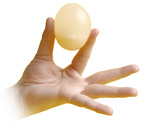|


A naked egg is an egg without a shell. Using vinegar, you
can dissolve the eggshell—without breaking the membrane
that contains the egg.
|
|
|
|
|
What
Do I Need?
|
.
|
|
•
a few eggs
|
|
|
•
white
vinegar
|
|
•
a container big enough to hold all your eggs
and a cover for the container
|
|
•
a
big spoon
|
|
|
|
|
What
Do I Do?
|
|
|
Here’s
how you dissolve the shell from your eggs:
|
|
|
|
|
|
1.
Place
your eggs in the container so that they are not touching.
|
|
|
|
|
|
2.
Add enough vinegar to cover the eggs. Notice that bubbles
form on the eggs. Cover the container, put it in the refrigerator,
and let the eggs sit in the vinegar for 24 hours.
|
|
|
|
|
3.
Use your big spoon to scoop the eggs out of the vinegar.
Be careful—since the eggshell has been dissolving, the
egg membrane may be the only thing holding the egg together.
The membrane is not as durable as the shell.
|
|
|
|
|
4.
Carefully dump out the vinegar. Put the eggs back in the
container and cover them with fresh vinegar. Leave the eggs
in the refrigerator for another 24 hours.
|
|
|
|
|
5.
Scoop the eggs out again and rinse them carefully. If any
of the membranes have broken, letting the egg ooze out, throw
those eggs away.
|
|
|
|
|
6.
When you’re done, you’ll have an egg without a
shell. It looks like an egg, but it’s translucent—and
the membrane flexes when you squeeze it. Very cool!
|
|
|
|
|
What
’
s
Going On?
|
|
|
When
you submerge an egg in vinegar, the shell dissolves. Vinegar
contains acetic acid, which breaks apart the solid calcium carbonate
crystals that make up the eggshell into their calcium and carbonate
parts. The calcium ions
float free (calcium ions are atoms that are missing electrons), while the carbonate goes to make carbon dioxide—the
bubbles that you see.
|
|
|
|
|
What
Else Can I Try?
|
.
|
|
•
The reaction of the eggshell and the vinegar is an acid-base
reaction. Calcium carbonate, a base, reacts with the acid
in the vinegar to make carbon dioxide. Baking soda is also
a base.
•
Try mixing baking soda and vinegar and see what happens! Use
this
mixture
to explode a plastic bag.
•
Once you’ve made a few shell-less eggs, you can experiment
by putting them in different solutions.
Here’s
how
. Keep your eggs in the refrigerator until you're ready
to do the experiments.
 Share
& Discuss
Share
& Discuss
|
|
